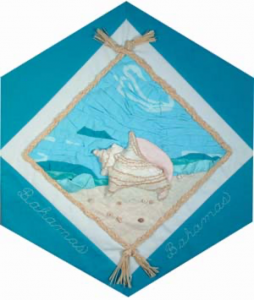Bahamas

The Block
This block was designed and created by Susan Cole with the help of Nancy Baker. It evokes an image of leisurely strolls along hot sandy beaches, a fitting tribute to the Bahamas, which is known for having the clearest waters in the world. Tonal zigzag stitches on moiré satin create a three-dimensional rugged outer shell of a conch (pronounced conk). Conch is an important part of Bahamians’ seafood diet, and the shells are frequently used to make jewellery. Nestled against the satiny-smooth inner shell is a replica of a very rare, pink conch pearl. Authentic sea-island (or long-staple) cotton, known for its lustre and silky feel, is gathered and folded to reproduce the cool, azure sky, monochromatic hues of satins form the crystal clear waters, and iridescent netting creates the appearance of the sun bouncing off white sand. A raffia braid, representing the basketry and weaving produced in the Bahamas, frames the scene. Straw work is a significant craft on the island and is taught at an early age to children learning at the feet of their mothers and grandmothers.
Cultural Profile
The Bahamas is an archipelago of over 2,000 cays and rock formations and nearly 700 islands, of which only about 30 are inhabited. The country is renowned for its beautifully landscaped gardens and colourful flowers, and for flocks of magnificent flamingos (the national bird). It is reported that the ratio of flamingos to people on Great Inagua is sixty-one to one. Upon observing the shallow sea around the islands, Christopher Columbus reportedly remarked “baja mar,” meaning low water or sea, and effectively named the area Bahamas or ‘The Islands of the Shallow Sea.’
The official language is English as the Bahamas were a British colony until they gained their independence in 1973, although Haitian immigrants speak their own Creole tongue. Over 90% of the islands’ present day population are descendants of freed slaves, slaves escaping from Florida or slaves brought in before the abolition of slavery in 1834.
A harmonious blending of peoples with different backgrounds, traditions, and beliefs has shaped Bahamian culture into a unique and colourful patchwork of daily life. Bahamians are a dynamic, independent and friendly people, many of whom have an artistic side they express through brightly coloured art, vibrant music, and exuberant dancing. Islanders have produced several traditional forms of music, including goomba (rhythm), which combines African and European influences, soca, and ‘rake ‘n’ scrape,’ which uses instruments made from materials at hand, showing great ingenuity. The Junkanoo parades held on Boxing Day and New Year’s Day feature elaborate costumes. Originating from the tradition of granting the slaves a day of rest around Christmas time to leave the plantations to celebrate with family, the Junkanoo continued after emancipation and now features lavish costumes, elaborate floats and music and dancing. The Bahamas is also known for its folklore, boat-building and carved wooden figures. Androsia cloth, a batik fabric, is produced on Andros Island and features distinctly Bahamian designs. Popular items with tourists include hats or baskets weaved locally using straw.
Bahamians have come to Canada for a variety of reasons, including education. Though their numbers are small their influence on Canadian culture is felt in areas such as art and cuisine, but is experienced most strongly in the musical arena, where the sounds of calypso, reggae and other West Indian styles are shared and enjoyed by all.
Sponsor: Joyce Jones, in the memorie of E. Donald Jones
